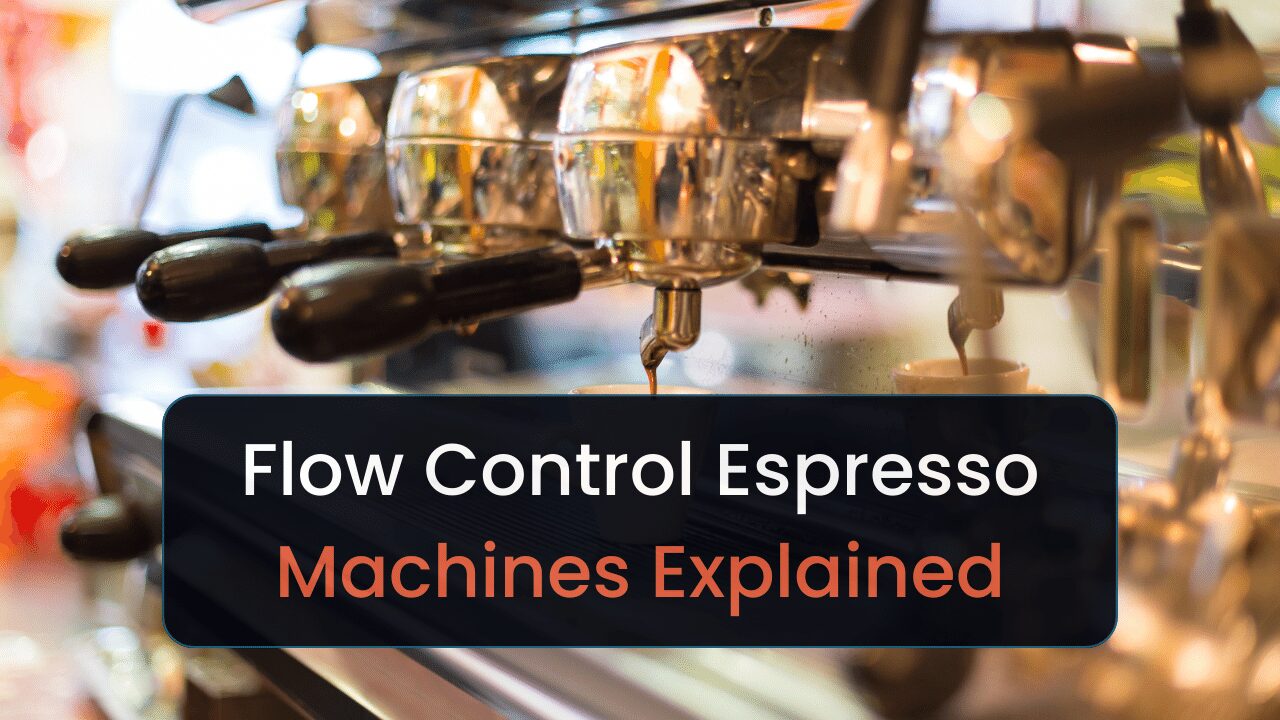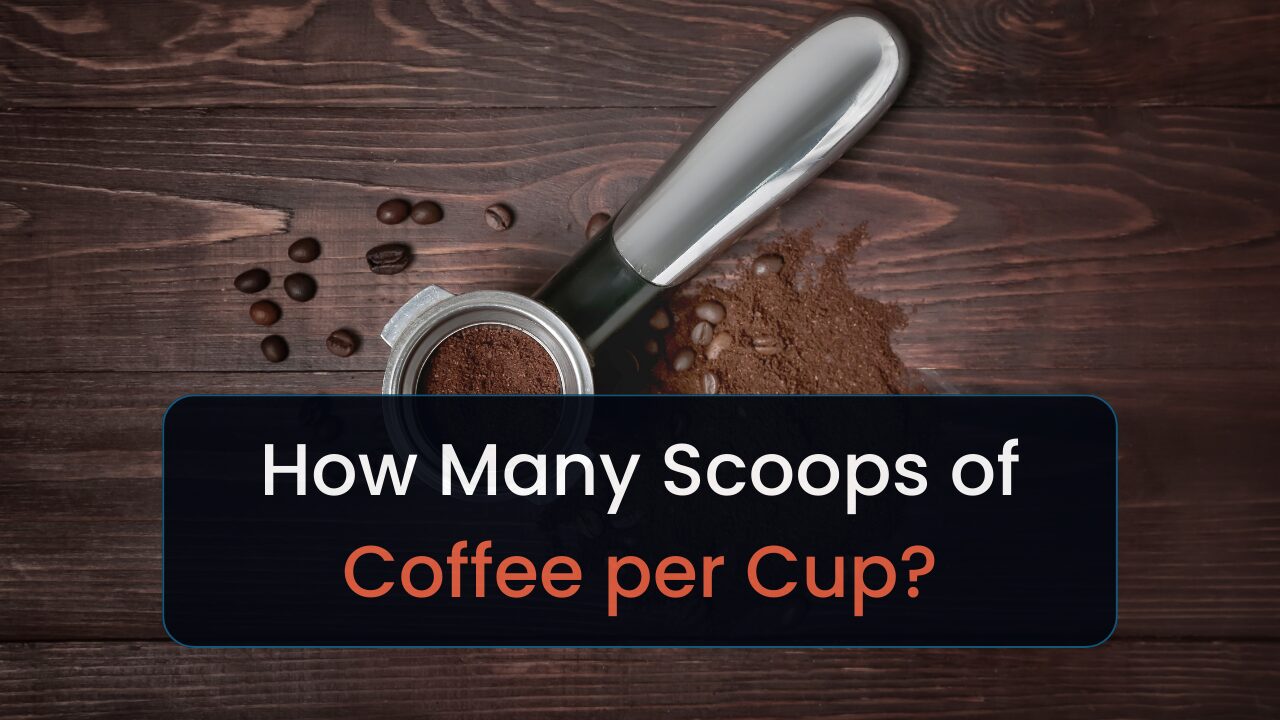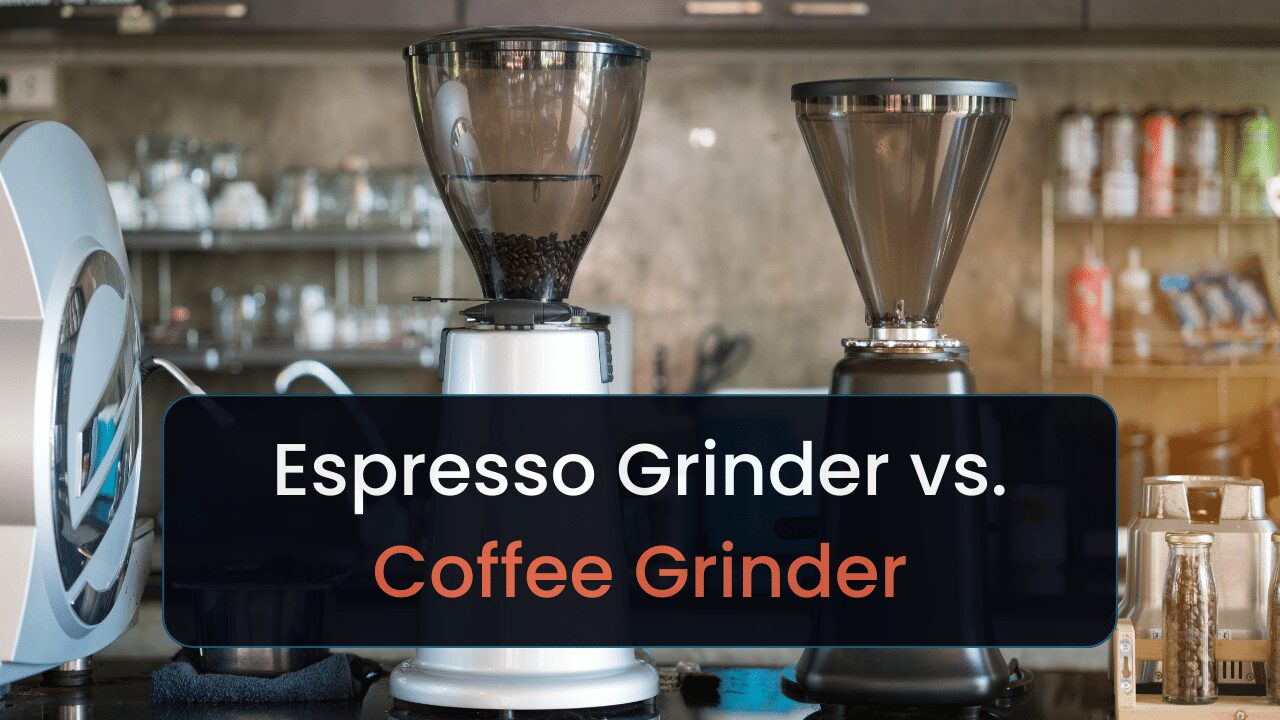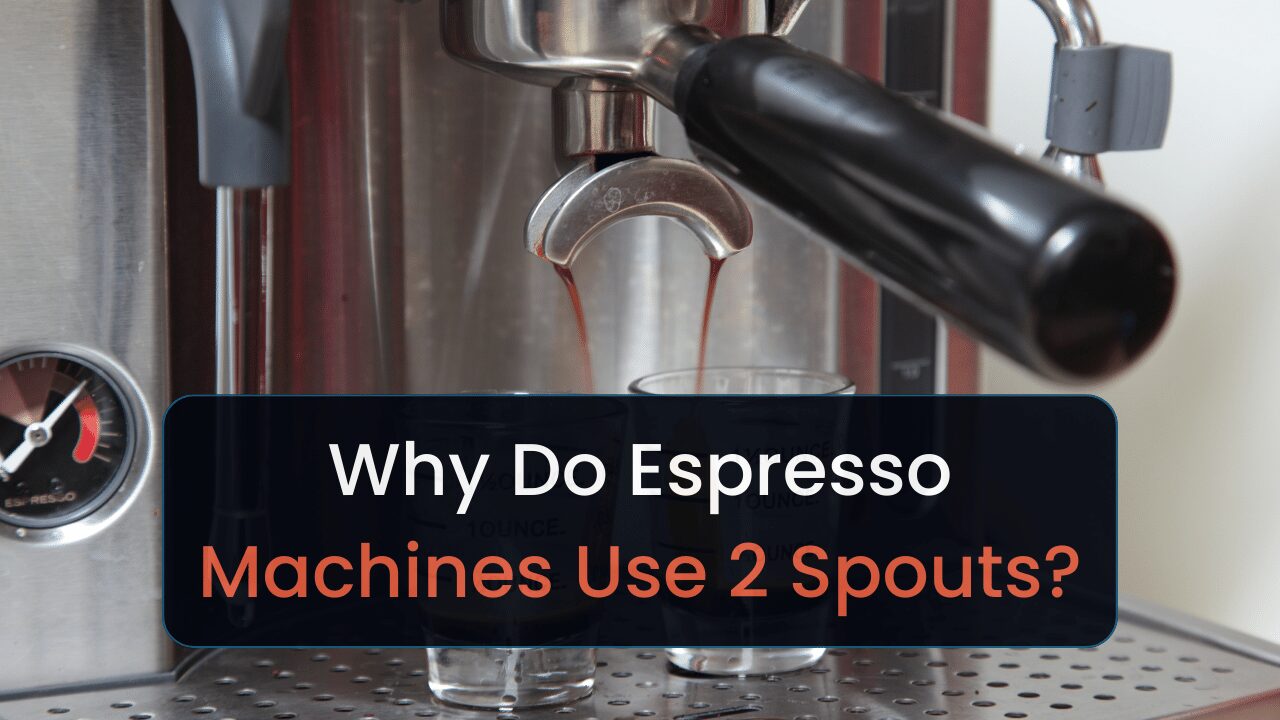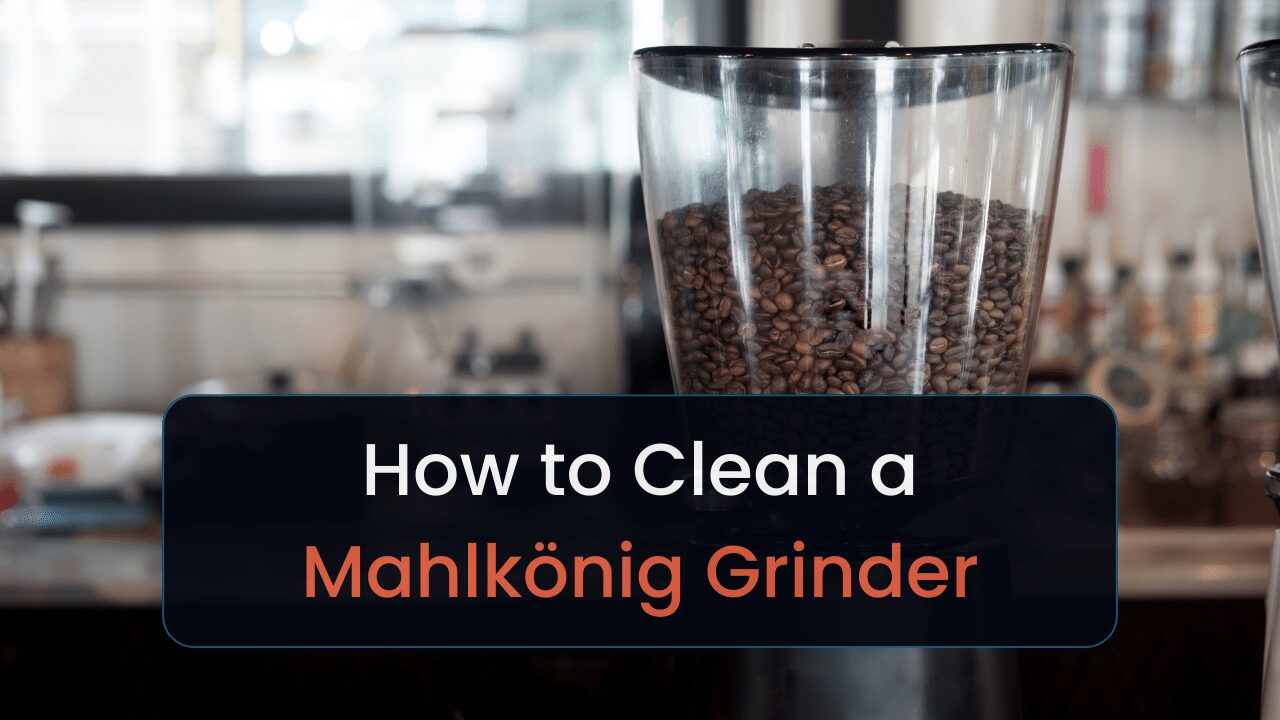Pump types make a huge difference in user experience and taste in espresso. That inspired me to write a piece about rotary vane pumps.
I’ll explain what rotary pumps are, their pros and cons, how they compare to vibratory pumps, and the best machines at different price points.
Here is an overview:
Dive in to learn more.
Key Takeaways
- Rotary pumps use a rotating disk to move water.
- They last 10 to 15 years.
- Usable in commercial espresso machines.
- Adds a lot more costs to espresso machines.
What Is a Rotary Pump?
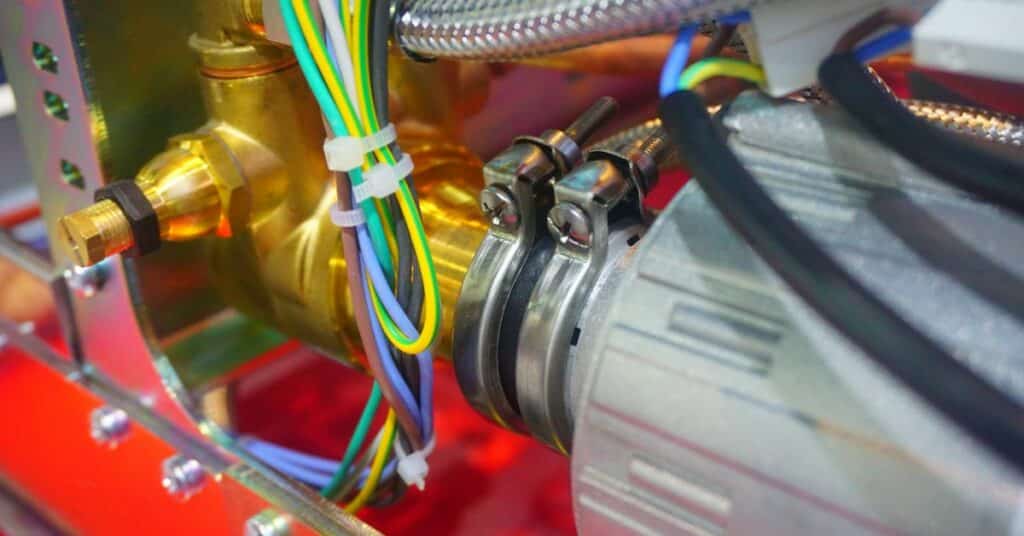
A rotary pump for espresso machines is a type of pump that uses a rotating disc to create pressure.
As the disc within the pump rotates, water enters through a port on a side and fills a chamber. From there, a vane inside the pump sweeps it through the pump’s side. The vanes spin at around 1,800 revolutions per minute (RPM) [1].
Rotary vane pumps are relatively quiet and durable, making them a good choice for commercial and home espresso machines. However, they’re much larger due to these pumps’ massive motors.
The large motor weighs around 5 pounds and can add a lot of extra mass to rotary pumps [2]. Making it not an exceptional choice for studio apartments, tiny homes, smaller kitchens, or RVs.
Commercial machines with rotary pumps have even larger motors that weigh more. But that won’t matter since you won’t need to move a machine around inside a coffee shop often.
Typical issues arising from rotary vane pumps are when the pins inside the vanes or the vanes themselves can wear out and cause the pump not to build pressure. These issues make rotary pumps better to repair than to replace.
Let’s dive into the pump’s pros and cons.
Advantages of Rotary Pumps
Pros of using rotary vane pumps include:
- Quieter operation: Better for not producing a lot of noise in the mornings.
- Longer lifespan: Can last more than 15 years [3].
- More consistent pressure: Builds up pressure quicker than vibratory pumps.
- Consistent flow of water: Produce a more consistent flow of water than vibratory pumps, which can help to ensure that espresso shots are extracted evenly.
These pumps have more consistent pressure, last longer, and operate quieter than vibratory pumps. All these factors combined lead to better-tasting espresso.
That makes rotary pumps more suitable for high-end espresso, commercial, and direct-plumbing machines. The last machine refers to devices you connect directly to your home’s water line.
It’s okay if you leave these pumps on for long periods, so long as they have fluids. However, they can run for short periods without fluids. Ensuring these machines would survive in a commercial setting.
Disadvantages of Rotary Pumps
Cons of using rotary pumps include:
- Larger: Leads to larger devices, which aren’t good for smaller kitchens.
- More complex: More complex than vibratory pumps, which can make them more difficult to repair.
- Higher cost: 10–20 times more expensive than vibratory pumps.
These machines work better for commercial settings or high-volume home use, but that results in an enormous price hike. These pumps are also more complex to repair due to the large number of parts and can result in larger machines.
How do these pumps compare to their counterpart, vibratory pumps?
Rotary Pump vs. Vibratory Pumps
Machines with rotary pumps work better for anyone who needs a commercial, high-end, or a device with a plumbing connection. Compatibility with the mentioned machines comes from this pump’s ability to handle high pressures.
They also don’t need replacements as frequently as vibratory pumps, which last 5–7 years.
Speaking of. Vibratory pumps work best for anyone who requires an entry-level or mid-range machine that’s compact and will fit in smaller kitchens.
Both pumps can run without fluid for a short period.
What Is a Vibratory Pump?
One type of pump that employs a vibrating component to transfer fluid is a vibratory pump. This vibrating component is usually a spring-connected piston or diaphragm that, when in motion, creates a pressure disparity that propels the fluid.
Vibratory Pump Pros & Cons
Pros of using vibratory pumps include:
- Cost-effective: Cheaper.
- Compact: Will fit in small spaces like tiny homes, studio apartments, & RVs.
Cons of using vibratory pumps include:
- Vibration & noise: Produces a lot of vibration & noise.
- Limited consistency: Espresso may not taste ideal.
- Unusable with direct water line machines: Can’t use these pumps with machines that directly connect to home’s plumbing.
These pros and cons suggest vibratory pumps aren’t top-of-the-line, but can provide a compact and affordable machine for homes and most espresso drinkers.
Taste Differences
Rotary vane pumps produce espresso with a superior flavor to most palates. The shots have a better mouthfeel along with a deeper and richer flavor. Shots that came from vibratory pumps were thinner and were not as bold-tasting.
Keep reading to see the best espresso machines with rotary pumps.
Best Rotary Pump Espresso Machines
The following sections will compare the pros and cons, specifications, features, and other information on the best espresso machines, including rotary pumps.
Most of these machines cost more than $2,000. Making them less-than-ideal for home baristas on a budget. If that’s something for you, check out our recommendations on affordable espresso machines.
1. La Spaziale S1 Vivaldi II: Best Entry-Level Machine
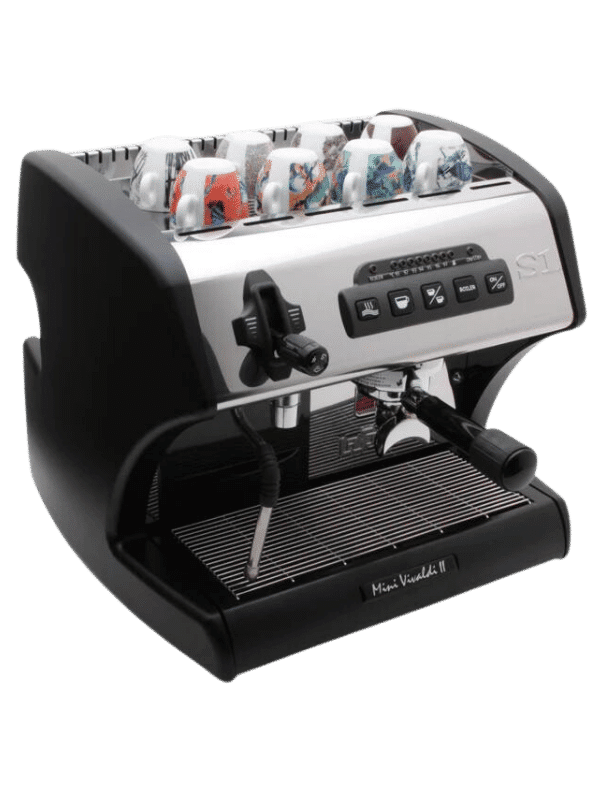
| Type | Semi-automatic |
| Dimensions | 16.5 × 16.5 × 15.25 in (D, W, H) |
| Boiler Type | Dual boiler |
| Warranty | 1 year |
| Water Capacity | Water line connection |
| Material | Stainless steel |
Pros
- Includes pre-infusion.
- Choose between 15 & 20 amps.
- Compact(ish).
Cons
Can’t adjust steam wand much.
The La Spaziale S1 Vivaldi 2 works best for anyone who wants an affordable machine with various high-end features.
It’s worth every penny if you’re after a machine that balances cost and great-tasting espresso.
The rotary pump, dual boilers, pre-infusion, and temperature regulation ensure you’ll have the highest-quality espresso regarding taste and temperature. I wouldn’t rely on this machine too much for making drinks like lattes.
The steam wand isn’t the most adjustable due to the lack of a ball joint, which gives you less control over your milk froth’s temperature. This lack of control could affect your milk-based espresso drink’s mouthfeel and taste.
By the way, pre-infusion means the machine will gently wet your espresso beans before brewing. This ensures you’ll have a more even flavor extraction.
However:
The machine’s compact, considering it’s a dual pump machine with a rotary pump. It’s not great for small kitchens, but if you have a table, dishwasher, or coffee cart you could place this on, it may fit.
Switching from 20 amps to the machine’s eco-mode (15 amps) gives you control over whether you want more power or to conserve electricity.
This machine only supports direct water line connections. If you want more flexibility, consider the next pick.
2. Quick Mill Vetrano 2B Evo: Best Mid-Range Machine
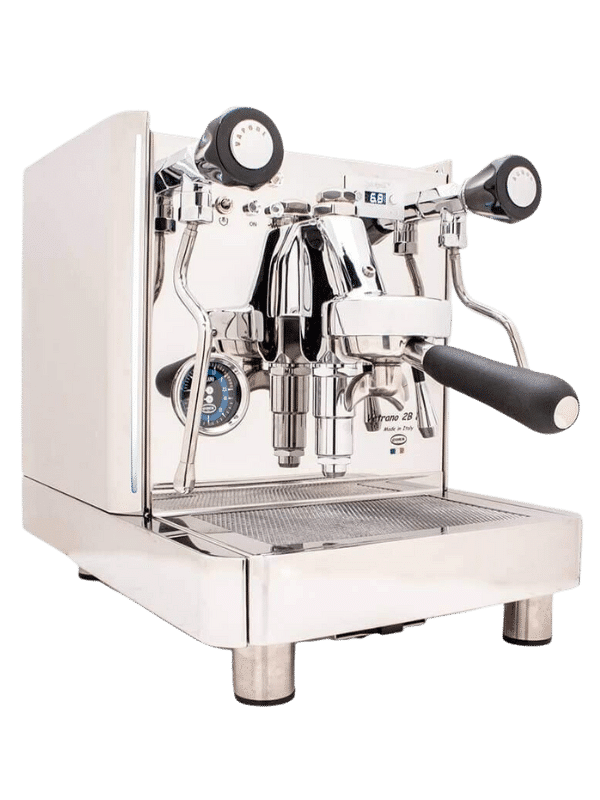
| Type | Semi-automatic |
| Dimensions | 18 × 12 × 16 in (D, W, H) |
| Boiler Type | Dual boiler |
| Warranty | 2 years |
| Water Capacity | 47 fl oz = 47 solo shots |
| Material | Stainless steel |
Pros
- Includes plumbing kit.
- Huge drip tray.
- Switch between 15 or 20 amps.
Cons
- Might need plumber to connect to plumbing line.
- LED could shine in eyes.
The Quick Mill Vetrano works best for anyone who wants a somewhat affordable machine that’ll connect directly to your home’s plumbing.
This coffee maker’s worth the money if you want something that balances great-tasting espresso, price, and convenience.
The huge drip tray is part of what makes this machine more convenient. Such a large tray reduces the times you’ll need to empty water and coffee.
The ability to switch between 15 or 20 amps enables you to have a powerhouse of a machine or one that’s more energy-efficient.
It also includes a plumbing kit. This lets you connect the Vetrano 2B Evo directly to your home’s plumbing. Doing so will eliminate the need to refill your machine constantly and could give you a means to filtered water. So long as you have it connected to filters.
Going this route will make your machine not portable, though. Switching between a reservoir and a water line connection doesn’t require many steps. That’s if you’re handy with plumbing.
If not, you’ll need to consider hiring a plumber to install it to your plumbing line, which would add an expense.
Otherwise, the other con for this machine comes from the LEDs. They’re bright and could affect your eyesight if you look directly into them. Something that would happen if you were to stare at any other light bulb for long enough.
Not the worst con, but I needed an additional disadvantage for this machine.
Want to spend more money on your espresso maker? Check out the next pick.
3. ECM Synchronika: Best High-End Machine
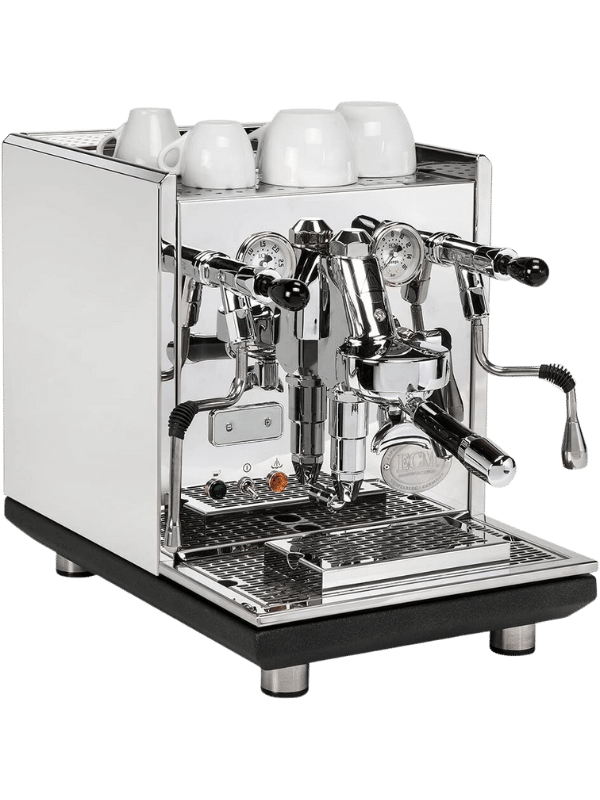
| Type | Semi-automatic |
| Dimensions | 18.7 × 13.25 × 16.25 in (D, W, H) |
| Boiler Type | Dual boiler |
| Warranty | 3 years |
| Water Capacity | 101.4 fl oz = 101 solo shots |
| Material | Stainless steel |
Pros
- Features PID.
- Includes pre-infusion.
- Durable parts.
Cons
- May develop a rattle.
- No mobile app.
The ECM Synchronika works best for anyone who wants a durable machine to produce the highest-quality espresso possible.
This Germany-made machine is worth the cost, considering its features.
It includes a rotary pump, which ensures quiet operation and better-tasting espresso. The pre-infusion feature will use low pressure to saturate beans before brewing. This helps with better flavor extraction.
The Proportional Integral Derivative (PID) constantly monitors your machine’s temperatures and makes minor adjustments to improve its temperature consistency. The Synchronika’s dual boilers will also ensure consistent temperatures and allow you to froth milk and brew simultaneously.
Then there’s your espresso’s water. It has a direct water line connection, allowing you to connect your machine directly to your home’s water line. Use this to connect the device to a filter to optimize your water’s mineral levels and taste.
It’ll also prevent you from needing to refill your water reservoir constantly.
Some folks have complained about the machine rattling. I couldn’t find any information on what could cause that. Perhaps, those customers had malfunctioning machines.
It also doesn’t have a mobile app to tell you when it’s time to descale your machine, temperature, and other stats. However, that’s not a deal killer since the machine already has many features.
It also has a highly durable build quality. It’s hand-made and has an internal steel frame to prevent the machine from bowing or bending due to continuous use.
We’ve recommended other direct-connection espresso machines in a separate piece. Check them out.
Businesses will want to check out this last option.
4. Dalla Corte XT: Best Commercial Machine
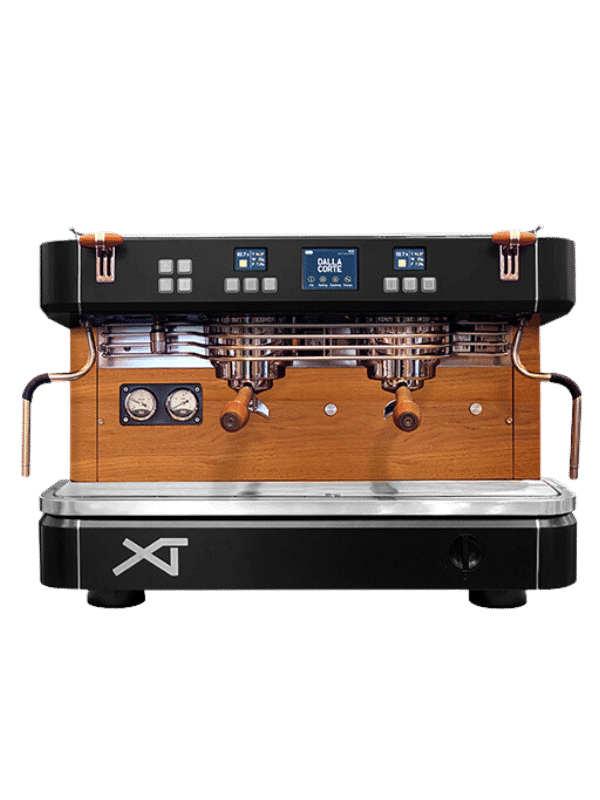
| Type | Semi-automatic |
| Dimensions | 20.08 × 37 × 20.67 in (D, W, H) |
| Boiler Type | Multi boiler (3 boilers) |
| Warranty | 1 year |
| Water Capacity | 253 fl oz = 253 solo shots |
| Material | Stainless steel |
Pros
- Automatic milk frother.
- Automatic backflush.
- Programmable buttons.
Cons
- No pre-infusion.
- Plastic portafilter handle.
The Dalla Corte XT 2-group machine works best for businesses that serve 50–300 drinks a day and want to automate many espresso-making parts for inexperienced or busy baristas.
Want to make more than 300 drinks? Upgrade to the 3-group version. This will support 300–600 drinks a day.
It’ll take around 5 minutes for the brew units to heat up. Making it ideal for serving many drinks back-to-back.
Each group head has its own dedicated boiler, ensuring your machine will have consistent temperatures for every drink. And it makes it easier to service them when needed without affecting the other group heads.
This machine doesn’t include pre-infusion. A feature that gently wets espresso beans before brewing to extract more flavors.
That con means nothing when bringing its automation into the picture. The automatic milk frother ensures consistent milk temperatures and consistency across all drinks. This feature also makes it easier for new hires to make drinks like lattes with minimal training.
The automatic backflush feature also eliminates some maintenance your team members need. This process requires you to perform several steps to clean your group head. But this machine will do it for you.
There’s also the programmable brew buttons. Use each button to set specific brew lengths for each drink. This allows you to create a template for specific drinks to ensure consistency.
It uses a plastic portafilter handle. While that won’t affect your coffee’s taste, it may not withstand constant use and handles made of more durable materials. You may want to consider replacing this.
Do you not care much for this machine? Explore other recommendations we’ve made for commercial espresso machines.
That’s all for our recommendations.
Conclusion
Rotary vane pumps are better for high-end, commercial, and machines that connect directly to your home’s plumbing due to their ability to handle high pressures and produce consistent pressure. They’re not great for folks on a budget, though.
Need more recommendations on high-end espresso machines? Check out our recommendations.

